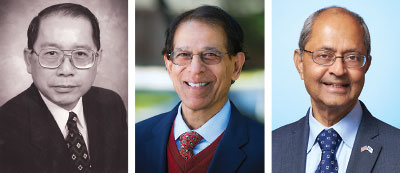APA Library Exhibit Recognizes Asian American Psychiatrists
Abstract
The exhibit is the fourth in a series honoring psychiatrists from APA’s minority/underrepresented groups.
A new exhibit at the APA Foundation’s Melvin Sabshin, M.D. Library & Archives explores the history of Asian American psychiatrists within APA and the impact they have had on the field.

An exhibit in the APA Foundation’s Melvin Sabshin, M.D. Library & Archives focuses on the past, present, and future of Asian American psychiatrists in APA. It features psychiatrists such as former Assembly Speaker Albert Gaw, M.D. (left), former APA President Dilip V. Jeste, M.D. (center), and APA President-Elect Ramaswamy Viswanathan, M.D., Dr.Med.Sc. (right).
The exhibit is the fourth in a series recognizing psychiatrists in APA’s minority/underrepresented groups, said Librarian and Archivist Deena Gorland, M.S.L.I.S. Titled “Asian American Psychiatrist Trailblazers: Past, Present, and Future,” it aims to highlight Asian American psychiatrists who have fostered a climate of inclusion in psychiatric training and have advocated to resolve the numerous challenges confronting psychiatrists of Asian origin in the U.S., Gorland said.
“We’re excited to share these stories of pioneering clinicians and thought leaders within the Asian American psychiatric community,” said Edmond Pi, M.D., a member of the APA Foundation’s Board of Directors. “Many of those featured in this exhibit are still practicing, paving the way for a new generation of Asian American and Pacific Islander psychiatrists committed to inclusivity. We are also grateful to Deena Gorland for her creative energies in spearheading this exhibit.”
The exhibit opened May 1 and will be open for at least six months. It is accompanied by a new online gallery that features more information about the many Asian American psychiatrists who have made a significant impact within APA and to the field of psychiatry. “The website will function as an added educational component so anyone can come and learn about the history of Asian American psychiatrists in APA,” Gorland said.
Features in the exhibit include a scrapbook page from the 1963 joint meeting of APA and the Japanese Society of Psychiatry and Neurology in Tokyo. The exhibit also highlights the contributions of numerous individual Asian American psychiatrists, such as Joe Yamamoto, M.D., Ph.D., who was one of the world’s best-known cross-cultural experts, and Lindbergh S. Sata, M.D., who was the first chairperson of the APA Task Force on Asian American Psychiatrists.
The task force convened in San Francisco on September 19, 1975. It was charged with providing a forum to explore issues and problems specific to Asian American psychiatrists and to discuss the clinical aspects of providing Asian American patients with culturally sensitive care. It became the Committee on Asian American Psychiatry in 1977 under APA’s Council on National Affairs and eventually became the APA Caucus of Asian American Psychiatrists.
In addition to detailing this history, the exhibit features important publications exploring the role of Asian American psychiatrists in the field. It highlights Elisabeth (Betty) C. Small, M.D., and the study she conducted in 1981 titled “A Survey of Asian American Women Psychiatrists,” which examined the background and experiences of Asian American women psychiatrists. ■
Resources
For more information or to schedule a visit to see the exhibit, contact [email protected].



